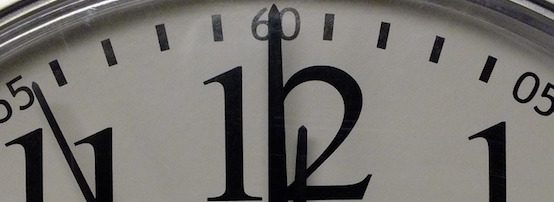
Time, as measured according to the Earth’s rotation, is getting slower. If we want 86,400 seconds to measure precisely one rotation of the earth on its axis then over time each second will have to get shorter.
Instead, we defined “one second” as a fixed unit of time, based on atomic vibrations (9,192,631,770 periods of the radiation emitted by a caesium-133 atom in the transition between the two hyperfine levels of its ground state).
But as the earth’s rotation slows, the fixed time period will mean that the time of day, the solar time, will drift. The resolution of this difference between a fixed time base and one that is relative to the earth’s rotation on its axis is to add (or subtract) a second from the fixed time base from time to time.
We humans have reserved two time slots each year to make this periodic correction: Midnight UTC on the 30th June, and midnight UTC on the 31st December.
The Earth Orientation Centre is the bureau that looks after this aspect of Universal Coordinated Time, and each six months they release a bulletin about their intentions for the next correction window. This month they announced a leap second to be scheduled for midnight UTC 31 December 2016.
INTERNATIONAL EARTH ROTATION AND REFERENCE SYSTEMS SERVICE (IERS) SERVICE INTERNATIONAL DE LA ROTATION TERRESTRE ET DES SYSTEMES DE REFERENCE SERVICE DE LA ROTATION TERRESTRE DE L'IERS OBSERVATOIRE DE PARIS 61, Av. de l'Observatoire 75014 PARIS France Tel: +33 1 40 51 23 35 e-mail: services.iers@obspm.fr web: http://hpers.obspm.fr/eop-pc Paris, 6 July 2016 Bulletin C 52 To authorities responsible for the measurement and distribution of time UTC TIME STEP on the 1st of January 2017 A positive leap second will be introduced at the end of December 2016. The sequence of dates of the UTC second markers will be:
- 2016 December 31, 23h 59m 59s
- 2016 December 31, 23h 59m 60s
- 2017 January 1, 0h 0m 0s
- from 2015 July 1, 0h UTC, to 2017 January 1, 0h UTC: UTC-TAI = -36s
- from 2017 January 1, 0h UTC, until further notice: UTC-TAI = -37s
What could possibly go wrong?
Previous experience has not been all good news. Many systems assume that if you sleep for 60 seconds, time will have advanced by 1 minute, or if you sleep for 86,400 seconds, the day counter will advance by 1 day. There have also been problems in high-resolution timers, where the addition of this extra second into the time record has caused the kernel of operating systems to enter a tight loop at an elevated priority, effectively shutting down any other useful activity in the host.
But we are accumulating experience with these spasmodic events, and we appear to be getting better at coping with this troublesome second. For example, one of the more inventive approaches is “leap second smearing”, where the single leap second is achieved by a thousand leap milliseconds, spread across a few hours of even a day.
I reported on this topic at some length back in 2012, so I won’t repeat it here. But it may pay to make a note that amongst all the New Year revels at the end of this year you should keep an eye on your systems to ensure that they comfortably handle a 61 second minute at the end of the UTC year.
The views expressed by the authors of this blog are their own and do not necessarily reflect the views of APNIC. Please note a Code of Conduct applies to this blog.

FYI – Perhaps one typo snuck in?
The line:
“from 2015 July 1, 0h UTC, to 2017 January 1, 0h UTC:
UTC-TAI = -6s”
should probably read:
“from 2015 July 1, 0h UTC, to 2017 January 1, 0h UTC:
UTC-TAI = -36s”
Great article (as always!)
/John
Well spotted John! Fixed.